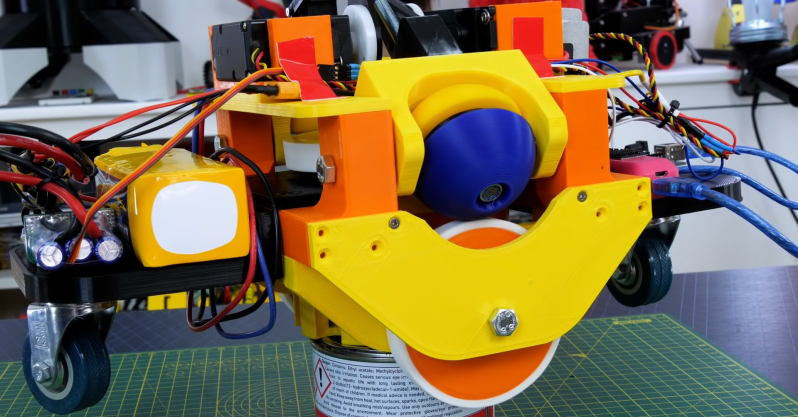[James Bruton] is experimenting is a series of interesting mechanical mechanisms, the latest being a CVT transmission system which uses a tilting sphere to get a variable speed output from a constant speed input. Video after the break.
In [James]’ proof of concept RC vehicle, a single powered disc is mounted on top, at 90 degree to the wheels. A rotating sphere makes contact with both the driven disc and the wheel. When the rotation axis of the sphere is at 45° between the disc and the wheel, it provides a one 1:1 transmission ratio. As the axis is tilted, the contact points on the sphere shift, changing the relative circumference at the contact points, and therefore changing the transmission ratio. It can also reverse by tilting the sphere in the opposite direction, and disconnected from the output wheel by aligning it with the hole in the bottom of the sphere. [James]’ simple two-wheel RC car concept quite well, driving around his kitchen with the transmission spheres being tilted by servos.
Thanks to the response time, CVT gearboxes are generally not needed for electric motors, but on internal combustion engines that which run best within a certain RPM range they can be very useful. One possible weak point of a design like this is it’s dependence on friction to transfer torque, which makes it vulnerable to wear and slipping.
This build is a spin-off of his spherical omni-wheels and the robot chassis he developed around them. For another interesting robot mechanism, check out is gyroscope balancing system.
Thanks for the tips [BaldPower] and [Mel]!
















This is the basis of the Kopp Variator, used in a number of lathes and other applications around the middle of the last century.
I did a rebuild of one some years ago, it’s an interesting device.
Pictures of the internals here: http://bodgesoc.blogspot.com/2016/01/holbrook6.html
An interesting point is that they claim that drive is by complicate rheology rather than friction, and only one very specific oil will work.
Also there are ramps in the input and output shaft bearing areas so that the drive discs are pushed in harder at higher loads.
My Priority Continuum Onyx bicycle (and many e-bikes) has a similar drive called an Enviolo CVT (previously marketed as Nuvinci). It’s a variable traction drive that is sealed and maintenance free. Efficiency is high when the in/out speed ratio is 1:1, but drops as the balls tilt in either direction, moving the gear ratio up or down. It can shift while stopped (about 1/3 of the range), rolling (full range), or pedaling (full range). The bike also has a Gates carbon belt drive system that is lubricant and maintenance free. It’s a little strange to ride as the shifting is instantaneous, perfectly smooth and absolutely silent.
They use them in this all-electric series as well.
https://www.greenpower.co.uk/
Snapper lawn mower variable speed drive anyone?
Yes, the Snapper lawn mower (the one Forrest Gump is driving at the end of the movie) has the wheel on disk version of this: I had one as a teenager! That form of transmission was used in the early 1900’s as an automobile transmission. Taking that idea, and some of what the Nuvinci does, and thinking about robotics several years ago, I was very excited about using it in robotics, just Danie is suggesting above:
https://patents.google.com/patent/US20190128390A1
I like this form of ball on disk. I have been assembling a number of new ideas, mainly about nice ways to create robotic joints, some of which I am very excited about again. The design above is a good option for certain situations.
How is it possible that this made it into a patent in 2019?
These friction drives have been in use for hundredths of years.
It’s just another example that the patent system is thoroughly broken.
It does seem very strange that the patent was granted. I have a 100 year old motorcycle which uses pretty much exactly that transmission. ( https://hackaday.com/tag/ner-a-car/ )
You aren’t reading very closely. It is not the disk on wheel friction CVT that was patented. That is only an element to which other things were added to do something apparently new.
Love those omniwheels, quite mesmerising. As for tilted ball CVTs, here’s a really elegant LEGO one I saw recently:
https://www.youtube.com/watch?v=LWWSCN71jrY
This is an elegant and beautifully produced video. Great find!
On a slightly different note:
Back in the early 80s (80-82), I ran across a newspaper article about a couple of fellows from Southern Alberta Institute of Technology (SAIT) who drove from Calgary to Edmonton on a gallon of gas. According to the article, the gas was to make up friction losses on a flywheel driven vehicle (flywheel power & storage). They had developed a fully automatic infinitely variable transmission – essential to efficient flywheel power storage for a vehicle.
I have never been able to find further mention of it. I was in a community college in Ontario at the the time. I do not remember which newspaper.
For non-Americans, they supposedly drove 300km on 3.78L of petrol.
Something based on this “singularity drive” seems to apply the same basic principles in a much more elegant way:
https://hackaday.com/2011/07/28/3d-printed-singularity-drive-platform/